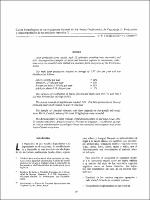Ciclos bioquímicos en un ecosistema forestal de los Andes Occidentales de Venezuela, 2: Producción y descomposición de los residuos vegetales.
Alternative title
Biochemical cycles in a forest ecosystem in the Western Andes of Venezuela, 2: Production and decomposition of plant residues.
Abstract
Litter production (tree stands, each 12 collectors; sampling every two weeks) and litter decomposition (samples of leaves and branches exposed to enviroment, collection every two months) were studied in a montane forest ecosystem of the Venezuelan Andes.
The total litter production reached an average of 6.97 Oa per year and was distributed as follows:
leaves 3.38 t/ha per year = 48%,
branches 2.27 t/ha per year = 33%,
flowers and fruits 1.09 t/ha per year =16%,
epiphytic plants 0.23 t/ha per year = 3%.
The variation of coefficients of leaves, flowers and fruits were low (14 and 26% ) and that for branches was high (64%).
The annual renewal of leaf-biomass reached 73%. The litter production in form of roots and dead wood yielded 14 and 4.8 t/ha/year.
The transfer of chemical elements with litter depends on the specific soil conditions For N, P and K, values of 69.4 and 33 kg/ha/year were recorded. The decomposition of litter is linear. Total decomposition of leaf litter occurs after 20 months exposition. Branches require 12 1/2 years to disappear. A coefficient of organic matter transformation according to Jenny was calculated and compared with other tropical forest ecosystems.
Keywords
Delegation
Sede Central
Publisher
Instituto Interamericano de Cooperación para la Agricultura (IICA)
Is part of
Turrialba; Vol. 31, no. 1
Status
openAccess
URI (Permanet link to cite or share this item)
https://repositorio.catie.ac.cr/handle/11554/12153Collections
- Turrialba [2688]


